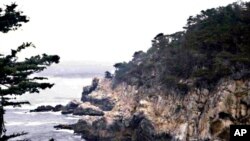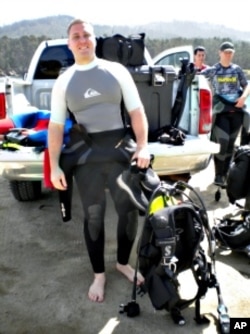The nation's oldest underwater reserve is one of nine protected marine areas along the California coast.
While Point Lobos Underwater Reserve is off-limits to fishermen, recreational divers enjoy the park's pristine conditions while scientists take advantage of the untouched eco-system to measure change over time to the environment.
Pristine conditions
Brandon Smith kneels down on the Point Lobos beach to double-check his SCUBA gear before he goes in the water. "You have to do everything a specific way every single time," he explains. "You don't want to make mistakes, because the worst time to find out that something's not working is, like, when you're [18 meters] under water."
Smith and his two companions are training to be on the Monterey County Sheriff's dive team, a law enforcement group that recovers criminal evidence from the water. Smith, a recreational diver and police officer, joined the group partly because he has always been fascinated with the ocean.
He says the expansive waters of Point Lobos have appealed to him for years. "It's just beautiful, but just specifically in Point Lobos, it just seems like everything's a little bigger. I never knew that starfish could ever get as big as they get. I mean to see one that's like [60 centimeters] in diameter and it's just cruising along the bottom, it's just kind of like, 'Whoa! Oh my god!' But it's a lot of fun."
He says a dive here is an eye-opening experience.
Luring scientists
The protected conditions at Point Lobos provide a base line to which researchers can compare data to measure environmental change.
"Without that base line, it's hard for us to try and ascertain if any of the differences or changes that we see long-term can be attributed, things like environmental change or human-mediated impact," says Dr. Corey Garza, an assistant professor in the division of Science and Environmental Policy at California State University-Monterey Bay.
He notes that the biggest threat to these protected underwater areas is people: poachers, boaters who spill oil, even visitors who disrupt the ecosystems by taking home souvenirs. Native Americans, Chinese fishermen and Japanese abalone harvesters have all called this area home at one point or another so, Garza says, the story of the park is also one of the human experience.
"We've changed our use of the environment over time and that's kind of one of the great historic things that marine reserves can do for us, just give us an estimate of how we've sort of changed some of these ecosystems, both through our use of it and in terms of what we're taking out of it."
Educating visitors protects park
Park rangers like Chuck Bancroft help maintain these protected marine areas by enforcing the park's rules, doing a little bit of everything related to the upkeep of the Reserve, and teaching the public about life underwater. Bancroft has worked at Point Lobos for close to 30 years, and loves talking to students about the marine life here and the history of Point Lobos. "To me, the thrill is being able to see things here and then pass it on to another generation," he says.
School groups come here from all around California, and other visitors come from even farther away. "We actually have handouts in 20 different languages to welcome people from around the world that come to visit here," Bancroft says.
"I remember one evening, I was closing up and a little car comes up and a gentlemen gets out and it turns out he's from Italy. And the only things he can say in English are 'Point Lobos' and 'Edward Weston'." Weston, an American photographer, created some of the magnificent photos of Point Lobos in the 1930s which still attract visitors today.
Preservation
California State University's Corey Garza says visitors like these, and divers like Brandon Smith, help make scientific research in the area is possible. "You can't have research and you can't have conservation unless you have a public that's actually invested in conserving that," he points out. "And so those parks actually provide for this educational aspect, as well helping people understand what the marine environment is, what's in there, and why is what you find in there important to them? So that's what I think the real big value of parks are."
Not only has this research added to our understanding of the ocean, it's helped shape government policies. Studies conducted by different institutes around Point Lobos provided the scientific basis for laws which created protected marine areas, including Point Lobos itself, which became a reserve in 1960.
As a diver, Brandon Smith understands the importance of protecting these areas, both for the creatures that live here and the people who enjoy it. "If you're going to learn about the ocean," he says, "there's no better way of learning it than seeing it first-hand."
Conservationists hope that scientists, and respectful visitors, will keep that possible at Point Lobos for years to come.
















